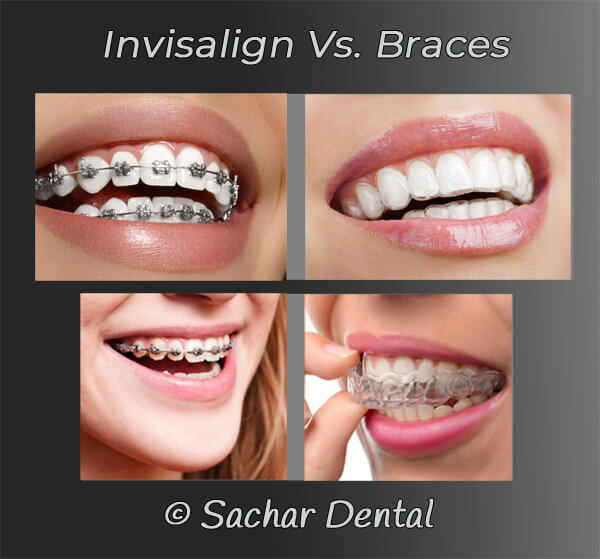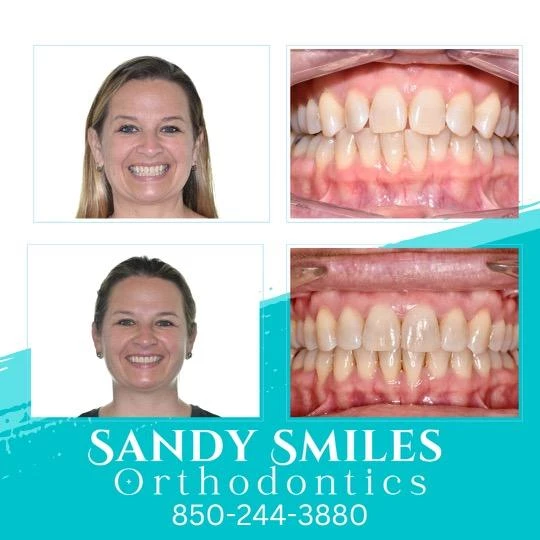The Ultimate Comparison: Invisalign vs. Traditional Braces for Adults
The Ultimate Comparison: Invisalign vs. Traditional Braces for Adults
Blog Article
Invisalign vs. Conventional Braces: Which Choice Is Right for You?
When taking into consideration orthodontic therapy, the choice in between Invisalign and typical dental braces provides a number of essential factors that merit mindful analysis. Invisalign uses a discreet alternative with removable aligners, while typical dental braces give an extra noticeable yet effective solution for severe misalignment.
Summary of Treatment Choices

In comparison, standard braces include metal brackets and cords that are adhered to the teeth. This approach uses constant stress in time to attain alignment. While efficient for intricate orthodontic issues, standard dental braces require regular visits for modifications and can present obstacles in maintaining oral health as a result of the difficulty of cleaning up about cables and brackets.
Both alternatives have their merits, and the option commonly pivots on specific dental conditions, way of life choices, and person compliance. Ultimately, consulting an orthodontic professional is vital for identifying the most appropriate therapy plan tailored to specific needs. Comprehending the subtleties of each option can substantially affect the total success of orthodontic therapy.
Aesthetic Considerations
A significant factor affecting the option between Invisalign and traditional braces is the visual allure each therapy uses. Invisalign aligners are crafted from clear plastic, making them essentially unnoticeable when used.
In contrast, conventional braces consist of metal brackets and cords, which can be extra recognizable. While developments in orthodontic innovation have actually brought about the advancement of smaller sized brackets and tinted elastics, standard braces still keep a more conspicuous account. For some individuals, the visibility of dental braces might discourage them from looking for needed treatment.
Ultimately, the selection between Invisalign and traditional dental braces may rest on personal preferences regarding appearances. Clients who focus on discretion frequently lean towards Invisalign, while those who are much less concerned concerning exposure might go with traditional braces. Recognizing the aesthetic implications of each option is critical for making an informed choice that lines up with one's way of life and choices.
Convenience and Convenience

In regards to benefit, Invisalign aligners are removable, enabling people to appreciate their preferred foods without limitation straight from the source and maintain optimum dental hygiene. Brushing and flossing are streamlined, as the aligners can be gotten during these routines, whereas typical dental braces require careful steering around brackets and wires.
In contrast, standard braces demand regular changes, making them much less convenient for those click to investigate with hectic timetables. In general, the convenience and convenience of Invisalign make it an attractive selection for numerous people seeking orthodontic treatment.
Therapy Duration and Performance
While both Invisalign and standard dental braces work in dealing with dental imbalances, the period of treatment can differ significantly between both alternatives. Generally, Invisalign therapy can take anywhere from 12 to 18 months, depending upon the intricacy of the situation. The clear aligners function by gradually moving teeth right into their desired placements, and regular follow-ups with an orthodontist assistance ensure progression stays on course.
In contrast, standard dental braces commonly require a longer commitment, normally varying from 18 months to three years. This is due to their fixed nature and using cables and braces, which can be more effective for extreme misalignments and complex situations (Invisalign). The therapy performance of traditional braces is well-documented, as they enable for specific changes and greater control over tooth movement
Ultimately, the choice between Invisalign and traditional braces might pivot on both the awaited therapy period and the certain dental problems available. Consulting with an orthodontist is critical, as they can give customized suggestions based on individual needs, ensuring the chosen approach straightens with preferred end results and durations.
Cost Contrast and Insurance Policy Alternatives
Cost plays a substantial duty in the decision-making procedure for individuals considering orthodontic therapy, whether choosing Invisalign or conventional dental braces. Generally, the expense of Invisalign ranges from $3,000 to $8,000, while traditional dental braces commonly set you back between $2,000 and $6,000. Variables affecting these costs consist of the intricacy of the situation, the duration of therapy, and geographical place.
Many oral insurance strategies offer partial insurance coverage for orthodontic treatments, yet the specifics can vary extensively. Typically, traditional dental braces may be a lot more frequently covered by insurance policy plans contrasted to Invisalign, which some insurance firms classify as a cosmetic treatment.
Additionally, wikipedia reference numerous orthodontic methods offer versatile layaway plan, making both treatment options extra available. Patients ought to ask concerning potential funding options and discount rates for ahead of time payments. Examining the overall price, consisting of insurance advantages and settlement plans, is necessary for making a notified decision that lines up with both aesthetic choices and budget plan factors to consider.

Conclusion
In summary, the selection in between Invisalign and conventional dental braces depends upon multiple factors, including visual choices, convenience, treatment duration, and cost. Invisalign offers a very discreet, detachable choice that assists in oral hygiene and nutritional flexibility, while traditional dental braces might be a lot more appropriate for complicated dental concerns and usually come with a lower price factor. Inevitably, examination with an orthodontist is necessary to evaluate individual conditions and figure out the most appropriate therapy choice for accomplishing optimal oral positioning.
When considering orthodontic therapy, the option between Invisalign and traditional dental braces provides several important variables that warrant cautious assessment.Comparing Invisalign and typical dental braces discloses distinctive therapy options for orthodontic correction.While both Invisalign and typical dental braces are efficient in fixing dental misalignments, the period of therapy can vary substantially between the two options.Cost plays a considerable function in the decision-making process for people thinking about orthodontic treatment, whether deciding for Invisalign or typical braces.In summary, the choice between Invisalign and typical braces pivots on several factors, consisting of aesthetic choices, comfort, treatment period, and cost.
Report this page